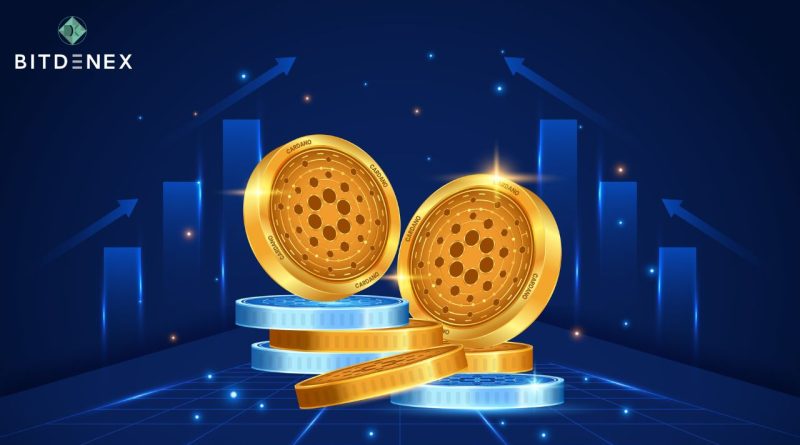What is Cardano?
Cardano is one of the most valuable cryptocurrencies in terms of market capitalization. It is intended to be a next-generation evolution of the Ethereum concept, with a blockchain that is a flexible, sustainable, and scalable platform for running smart contracts, allowing the development of a diverse range of decentralized finance apps, new crypto tokens, games, and more.
However, as of March 2021, developers had yet to implement smart-contract functionality. An upgrade scheduled for the second quarter of 2021 will enable smart-contract features, bringing Cardano one step closer to its goal of providing developers with a robust, secure, scalable, and highly energy-efficient blockchain platform.
The Cardano blockchain’s native cryptocurrency, ADA, is similar to the Ethereum blockchain’s native cryptocurrency, ETH, and can be purchased or sold on exchanges such as Bitdenex. ADA can now be used to store value (perhaps as part of an investment portfolio), send and receive payments, stake, and pay transaction fees on the Cardano network.
How does Cardano work?
Cardano aspires to be the most environmentally friendly blockchain platform. It employs a novel proof-of-stake consensus mechanism known as Ouroboros, as opposed to the energy-intensive proof-of-work system that Bitcoin and Ethereum currently employ. (With the ETH2 upgrade, Ethereum will also transition to a proof-of-stake system).
What is proof of work? Without a central authority like Visa or PayPal in the middle, decentralized cryptocurrency networks must ensure that no money is spent twice. They use a “consensus mechanism” to accomplish this. Proof of work is the original crypto consensus mechanism, which was popularised by Bitcoin mining.
- Virtual “miners” around the world compete to solve time-consuming math puzzles in order to prove their work. Proof of work requires a huge amount of processing power.
- As a prize, the winner gets to update the blockchain with the latest verified transactions and gets a certain amount of cryptocurrency.
What is proof of stake? Proof of stake, as opposed to a network of miners racing to solve a puzzle, employs a network of invested participants known as validators. Validators stake their own ADA rather than contributing processing power to secure the network and verify transactions, as miners do.
- As a result, the network selects a winner based on how much ADA each validator has in the pool, as well as the duration of their participation.
- After the winner has validated the most recent block of transactions, other validators can attest to its accuracy. The blockchain is updated when a certain number of attestations are received.
- The network distributes rewards in ADA proportionally to the stakes of participating validators.
The Cardano blockchain has two layers: the Cardano Settlement Layer (CSL) and the Cardano Computing Layer (CCL). The CSL contains the account ledger and balances (and is where the Ouroboros consensus mechanism validates the transactions). The CCL layer is where all computations for apps running on the blockchain are executed — via smart contract operations.
What are Cardano native tokens?
The Cardano blockchain enabled the creation of native tokens on March 1, 2021. Cardano native assets, like Ethereum tokens (which can include NFTs or stablecoins like USD Coin), can be created and distributed on the blockchain and interact with smart contracts.
Cardano native tokens, unlike Ethereum-based tokens, are not created through a smart contract. They instead use the same architecture as the ADA cryptocurrency. Cardano native assets are now “first-class citizens” on the blockchain, according to the non-profit Cardano Foundation. Their native architecture can theoretically make these tokens more secure and reduce transaction fees.
A brief history of Cardano
Cardano, founded by Ethereum co-founder Charles Hoskinson in September 2017, aims to be a third-generation blockchain (or blockchain 3.0) project, building on the technology pioneered by Bitcoin (first-gen) and Ethereum (second-gen). Cardano’s vision is to be a highly scalable, low-energy smart contract platform.
A team of computer scientists and cryptographers from the University of Edinburgh, Tokyo University, and other institutions developed the Ouroboros consensus mechanism through peer-reviewed research. Their goal was to create a decentralized network capable of validating transactions in a scalable and secure manner, while also ensuring that the Cardano platform was as energy-efficient as possible.
What is ADA?
The Cardano platform’s native cryptocurrency is ADA (named after Ada Lovelace, the 19th-century mathematician widely regarded as the “world’s first computer programmer”). ADA tokens power the Cardano platform in the same way that ETH tokens power the Ethereum platform. They are used to pay transaction fees and are staked by validators (and delegators) who want to contribute to the network’s security and stability in exchange for rewards. ADA will be used as a governance token in the future, allowing holders to vote on changes and upgrades to the Cardano platform.
What’s next for Cardano?
Smart contract functionality is expected to be added to the Cardano platform in the second quarter of 2021. The blockchain will also be compatible with Ethereum-based smart contracts later this year, potentially allowing it to run a wide range of existing apps and allowing developers to work on Cardano projects using the familiar Solidity programming language. Cardano also intends to become completely decentralized by implementing community-driven governance and an automated treasury system to fund the network’s future.
Buy and sell crypto in minutes with 0.20% trading fees at Bitdenex Exchange.

